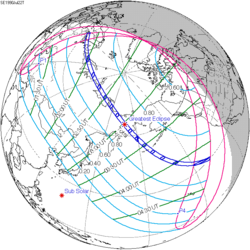| Partial eclipse | |
| Gamma | 1.0191 |
|---|---|
| Magnitude | 0.9749 |
| Maximum eclipse | |
| Coordinates | 61°18′N150°18′E / 61.3°N 150.3°E |
| Times (UTC) | |
| Greatest eclipse | 8:54:27 |
| References | |
| Saros | 126 (50 of 72) |
| Catalog # (SE5000) | 9647 |
A partial solar eclipse will occur at the Moon's descending node of orbit on Sunday, September 3, 2062, [1] with a magnitude of 0.9749. A solar eclipse occurs when the Moon passes between Earth and the Sun, thereby totally or partly obscuring the image of the Sun for a viewer on Earth. A partial solar eclipse occurs in the polar regions of the Earth when the center of the Moon's shadow misses the Earth.
Contents
- Eclipse details
- Eclipse season
- Related eclipses
- Eclipses in 2062
- Metonic
- Tzolkinex
- Half-Saros
- Tritos
- Solar Saros 126
- Inex
- Triad
- Solar eclipses of 2062–2065
- Saros 126
- Metonic series
- Tritos series
- Inex series
- References
- External links
The partial solar eclipse will be visible for parts of Greenland, Northern Europe, and Asia.




























































































